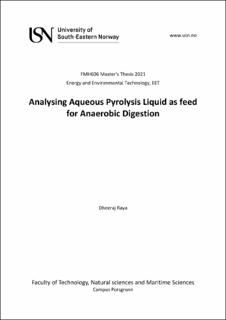| dc.description.abstract | Lignocellulosic biomass contains cellulose and hemicellulose which makes it suitable for Anaerobic Digestion (AD) process. However, due to complexity of the lignocellulosic biomass, pretreatment methods should be used to make it more easily degradable. Pyrolysis, one of the pretreatment method, results in formation of Aqueous pyrolysis liquid (APL) as a product. APL are known to have high chemical oxygen demand. Thus, it shows potential to be used as feed for AD process to produce methane but it contains toxic compounds such as phenols, furfural, HMF, acetones, and many others, most of which are known to inhibit the AD process. In this thesis, APL obtained from Scanship AS, is evaluated by carrying batch experiment to understand its methane potential and to understand organic loads where it disturbs the AD process. Co-digestion of APL with hydrolyzed sludge (HS) was also carried out to test its potential to be used as co-substrate. Finally, ADM1 model was extended by addition of inhibitory compounds (phenol, furfural and HMF) to model the methane production rate which was observed during experiment.
The results show that by addition of APL in range of (5-20 % of COD) during co-digestion increased the methane yield by 8-23% and shows potential to be used as co-substrate during AD process. However, during batch test of APL, increasing the organic load resulted in decrease in methane yield. Organic load above 2 gCOD/L severely inhibited the AD process by showing very low methane production rate. In contrast, batch test of APL with low organic load showed good methane production rate.
Since, APL contains numerous compounds, inoculum stored for 2 months showed decrease in methane yield for all the organic load tested. Thus, it is recommended to use fresh and diverse inoculum as possible.
Simulation performed with standard ADM1 models was not able to predict the methane production rate from APL. However, extended ADM1 model showed ability to handle APL for predicting behavior of APL and inhibition constant was the most sensitivity parameter which could affect the methane production rate. APL with low organic load was predicted well by extended ADM1 model. Use of low inhibition constant and low startup concentration of biomass during simulation of APL with higher organic load resulted in good fit with experimental results suggesting implementation of further compounds which could inhibit AD process would increase the model predictability. | |
